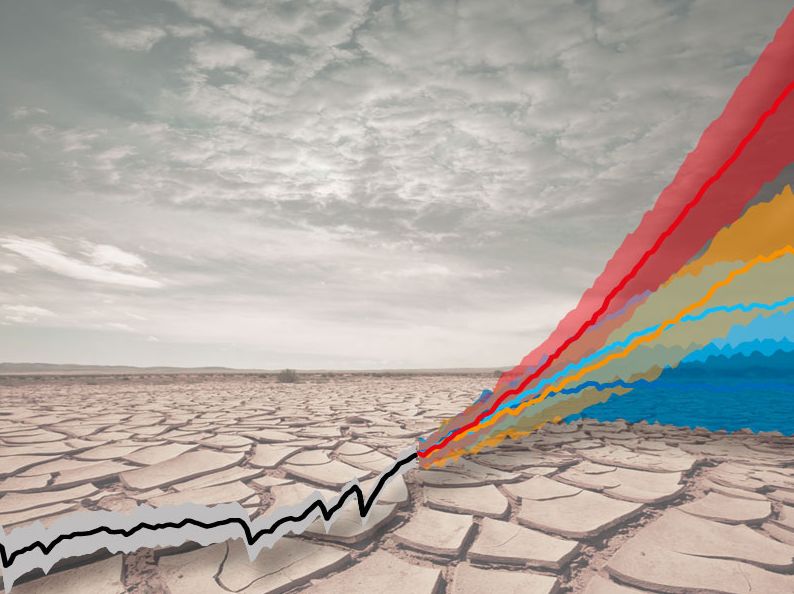Even with the latest climate models, temperature projections are full of uncertainties (bright areas around temperature curves for different scenarios). Credit: Josef Kuster, ETH Zurich / Knutti and Sedlacek 2012 Nature Climate Change / Galyna Andrushko, Fotolia
(Phys.org)—How accurate are the latest generation of climate models? Climate physicist Reto Knutti of ETH Zurich has compared them to older models and draws a nuanced conclusion: While climate modeling has made substantial progress in recent years, one should also be aware of its limitations.
We know that scientists simulate the climate on computers. Much of their work, however, is devoted to improving and refining the simulations: they incorporate recent research results into their computer models and test them with increasingly large measurement data sets. Consequently, the climate models used today are not the same as those used five years ago when the Intergovernmental Panel on Climate Change (IPCC) published its last report. But is the evidence for the new, more complex and detailed models always the same? Or has five years of climate research upended old projections?
It is questions like these that hundreds of climatologists have pursued in recent years, joining forces to calculate the climate of the future with the thirty-five existing models. With his team, Reto Knutti, professor of climatic physics, analyzed the data and compared them with those of the old models. In doing so, the researchers from ETH-Zurich came to the conclusion: hardly anything has changed in the projections. From today’s perspective, the predictions of five years ago were already remarkably good. “This is great news from a scientific perspective,” says Knutti. Apparently, however, all is not good: the uncertainties of the old projections still exist. “We are still convinced that the climate is changing due to high levels of greenhouse gas emissions. However, information on the degree of warming or drought is still uncertain in many places,” says Knutti. One is therefore inclined to complain that the last five years of climate research have led nowhere – at least as far as the citizens or decision-makers who rely on accurate projections are concerned.
Simplify models in different ways
Knutti sees this in a slightly more differentiated light. For him, there are plausible explanations for why uncertainties cannot be removed more efficiently: they arise because each of the thirty-five models sets different priorities for breaking down the hugely complex climate system in such a way that it can even be simulated on a full-scale computer in the first place. The different models also give slightly different results and therefore a certain range of projections.
One might assume that the more scientists focus on the climate, the more accurate the results of the model’s calculations should become and, therefore, the projections of the individual models should converge. According to Knutti, however, this assumption may well be true in the long term, but not in the short term. After all, the more complex a model becomes, the more processes are taken into account in it and, unfortunately, the greater the uncertainty becomes in the short term. “The models may not have become more accurate over the past five years, but they are more reliable, especially as current models consider physical processes more realistically,” says the climate physicist.
Weather more variable than you think
As Knutti’s results reveal, climate models may well be able to reliably calculate trends, but eventually they reach their limits. Such a limitation is also apparent in the current trend of making increasingly small, short-term climate projections, Knutti says and refers to another study by him and other climate researchers that was recently published. “Whether there will be an increase in heat waves or particularly cold winters in the United States, Europe or Russia in the next twenty years certainly does not depend solely on human-caused climate change,” Knutti points out. The frequency of locally stable meteorological situations has an impact on this in particular. And these have been heavily influenced by phenomena such as the North Atlantic Oscillation, which (unlike the long-term man-made trend) cannot be predicted many years in advance.
The problem with the new short-term projections: the shorter the time scale, the weaker the influence of the anthropogenic trend and the greater that of variable weather events. Especially in the mid-latitudes we live in, weather phenomena vary greatly and human-caused climate change is obscured by them. Therefore, as the researchers write in their study, it is difficult to make short- and medium-term climate predictions, no matter how good the models.
Robust heat stress projections
Hard-to-predict climatic events also include extreme weather events such as floods, droughts or heat waves. Interestingly, however, combined measurements of atmospheric temperature and humidity can be predicted quite well. All climate models give similar results for these measurements, as Knutti and Erich Fischer, a senior researcher in his team, were able to demonstrate recently in a third study. “It’s important because the risk of heatstroke is higher when it’s hot and humid at the same time, for example,” says Fischer. The fact that combined measurements of atmospheric temperature and humidity can be so well predicted has to do with the fact that temperature and humidity also depend on each other through physical processes. One of the reasons the temperatures were so high during the so-called heat wave of 2003, for example, is that it was so dry that hardly any soil moisture could evaporate.
Even if climate projections sometimes reach their limits due to divergent forecasts and the influence of unpredictable weather phenomena, accurate projections are therefore perfectly feasible in some areas as well – projections which will also influence the next IPCC report, which will be published in September 2013.
Tropical clouds hold clues to the global water cycle
Knutti R, Sedlacek J: Robustness and uncertainties in new CIMP5 climate model projections. Natural climate change2012, Advance publication online, DOI: 10.1038/nclimate1716
Deser C, Knutti R, Solomon S, Phillips AS: Communicating the role of natural variability in the future North American climate, Natural climate change, 2012, 2: 775-779, DOI: 10.1038/nclimate1562
Fischer EM, Knutti R: Robust projections of combined humidity and temperature extremes. Natural climate change2012, Advance publication online, DOI: 10.1038/nclimate1682
Quote: The limitations of climate models (2012, November 7) retrieved July 10, 2022 from https://phys.org/news/2012-11-limitations-climate.html
This document is subject to copyright. Except for fair use for purposes of private study or research, no part may be reproduced without written permission. The content is provided for information only.




